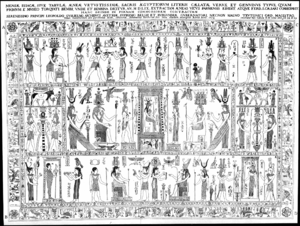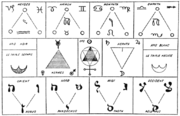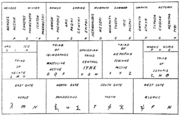
Bembine Tablet
Encyclopedia

Ancient Rome
Ancient Rome was a thriving civilization that grew on the Italian Peninsula as early as the 8th century BC. Located along the Mediterranean Sea and centered on the city of Rome, it expanded to one of the largest empires in the ancient world....
origin and mimicking Egyptian
Ancient Egypt
Ancient Egypt was an ancient civilization of Northeastern Africa, concentrated along the lower reaches of the Nile River in what is now the modern country of Egypt. Egyptian civilization coalesced around 3150 BC with the political unification of Upper and Lower Egypt under the first pharaoh...
style. It was used by the 17th century hermeticist
Hermeticism
Hermeticism or the Western Hermetic Tradition is a set of philosophical and religious beliefs based primarily upon the pseudepigraphical writings attributed to Hermes Trismegistus...
Athanasius Kircher
Athanasius Kircher
Athanasius Kircher was a 17th century German Jesuit scholar who published around 40 works, most notably in the fields of oriental studies, geology, and medicine...
as the primary source for developing his translations of Egyptian hieroglyphics; the hieroglyphics on the Tablet are now known to be nonsense, and Kircher's translations spurious.
It was also celebrated by later occultists including Eliphas Levi
Eliphas Levi
Eliphas Lévi, born Alphonse Louis Constant , was a French occult author and purported magician."Eliphas Lévi," the name under which he published his books, was his attempt to translate or transliterate his given names "Alphonse Louis" into Hebrew although he was not Jewish.His second wife was...
, William Wynn Westcott
William Wynn Westcott
William Wynn Westcott was a coroner, ceremonial magician, and Freemason born in Leamington, Warwickshire, England...
and Manly P. Hall as a key to interpreting the "Book of Thoth" or Tarot
Tarot
The tarot |trionfi]] and later as tarocchi, tarock, and others) is a pack of cards , used from the mid-15th century in various parts of Europe to play a group of card games such as Italian tarocchini and French tarot...
, and Thomas Taylor even claimed that this tablet formed the altar before which Plato
Plato
Plato , was a Classical Greek philosopher, mathematician, student of Socrates, writer of philosophical dialogues, and founder of the Academy in Athens, the first institution of higher learning in the Western world. Along with his mentor, Socrates, and his student, Aristotle, Plato helped to lay the...
stood as he received initiation within a subterranean hall in the Great Pyramid of Giza
Great Pyramid of Giza
The Great Pyramid of Giza is the oldest and largest of the three pyramids in the Giza Necropolis bordering what is now El Giza, Egypt. It is the oldest of the Seven Wonders of the Ancient World, and the only one to remain largely intact...
. The Tablet was named after Cardinal Bembo, a celebrated antiquarian who acquired it after the 1527 sack of Rome
Sack of Rome (1527)
The Sack of Rome on 6 May 1527 was a military event carried out by the mutinous troops of Charles V, Holy Roman Emperor in Rome, then part of the Papal States...
.
Origins
The Tablet has been dated to some time in the first century, probably originating in RomeRome
Rome is the capital of Italy and the country's largest and most populated city and comune, with over 2.7 million residents in . The city is located in the central-western portion of the Italian Peninsula, on the Tiber River within the Lazio region of Italy.Rome's history spans two and a half...
. Nothing is known of it until after the sack of Rome. Cardinal Bembo acquired it at an exorbitant price from a certain locksmith or ironworker into whose hands it had fallen. After Bembo's death in 1547 the Tablet was acquired by the House of Mantua, remaining in their museum until the capture of Mantua
Mantua
Mantua is a city and comune in Lombardy, Italy and capital of the province of the same name. Mantua's historic power and influence under the Gonzaga family, made it one of the main artistic, cultural and notably musical hubs of Northern Italy and the country as a whole...
in 1630 by Ferdinand II
Ferdinand II, Holy Roman Emperor
Ferdinand II , a member of the House of Habsburg, was Holy Roman Emperor , King of Bohemia , and King of Hungary . His rule coincided with the Thirty Years' War.- Life :...
's troops. The Tablet eventually came into the hands of Cardinal Pava, who presented it to the Duke of Savoy, who in turn presented it to the King of Sardinia
Sardinia
Sardinia is the second-largest island in the Mediterranean Sea . It is an autonomous region of Italy, and the nearest land masses are the French island of Corsica, the Italian Peninsula, Sicily, Tunisia and the Spanish Balearic Islands.The name Sardinia is from the pre-Roman noun *sard[],...
. With the French conquest of Italy in 1797 the Tablet came to Paris
Paris
Paris is the capital and largest city in France, situated on the river Seine, in northern France, at the heart of the Île-de-France region...
, and Alexandre Lenoir
Alexandre Lenoir
Marie Alexandre Lenoir was a French archaeologist. Self-taught and devoted to saving France's historic monuments, sculptures and tombs from the ravages of the French Revolution, notably those of Saint-Denis and Sainte-Geneviève.- Life :The ravages of the Revolution caused the birth of the Musée...
wrote in 1809 that it was on exhibition in the Bibliothèque Nationale
Bibliothèque nationale de France
The is the National Library of France, located in Paris. It is intended to be the repository of all that is published in France. The current president of the library is Bruno Racine.-History:...
. It was later returned to Italy
Italy
Italy , officially the Italian Republic languages]] under the European Charter for Regional or Minority Languages. In each of these, Italy's official name is as follows:;;;;;;;;), is a unitary parliamentary republic in South-Central Europe. To the north it borders France, Switzerland, Austria and...
after peace was established. Karl Baedeker
Karl Baedeker
Karl Baedeker was a German publisher whose company Baedeker set the standard for authoritative guidebooks for tourists.- Biography :...
in his Guide to Northern Italy mentions that the tablet was a central exhibit in Gallery 2 in the Museum of Antiquities at Turin
Turin
Turin is a city and major business and cultural centre in northern Italy, capital of the Piedmont region, located mainly on the left bank of the Po River and surrounded by the Alpine arch. The population of the city proper is 909,193 while the population of the urban area is estimated by Eurostat...
, where it is today.
Construction
Kircher describes the Tablet as "five palms long and four wide", while Westcott measures it at 50×30 inches. It was made of bronze with enamel and silver inlay, the figures cut very shallow and the contours of most of them delineated with thin silver wire. The bases on which the figures sat were covered with silver, which had been torn away, and these sections are left blank in the engraved reproduction.The Tablet is an important example of ancient metallurgy
Metallurgy
Metallurgy is a domain of materials science that studies the physical and chemical behavior of metallic elements, their intermetallic compounds, and their mixtures, which are called alloys. It is also the technology of metals: the way in which science is applied to their practical use...
, its surface being decorated with a variety of metals including silver, gold, copper-gold alloy and various base metals. One of the metals employed is black, made by alloying copper and tin with small amounts of gold and silver, and then 'pickling' it in organic acid
Acid
An acid is a substance which reacts with a base. Commonly, acids can be identified as tasting sour, reacting with metals such as calcium, and bases like sodium carbonate. Aqueous acids have a pH of less than 7, where an acid of lower pH is typically stronger, and turn blue litmus paper red...
. This black metal
Black metal
Black metal is an extreme subgenre of heavy metal music. Common traits include fast tempos, shrieked vocals, highly distorted guitars played with tremolo picking, blast beat drumming, raw recording, and unconventional song structure....
is possibly a variety of the "Corinthian bronze
Corinthian bronze
Corinthian bronze, also called Corinthian brass or æs Corinthiacum, was a highly valuable metal alloy in classical antiquity. It is thought to be an alloy of copper with gold or silver , although it has also been contended that it was simply a very high grade of bronze, or a kind of bronze that...
" described by Pliny
Pliny the Elder
Gaius Plinius Secundus , better known as Pliny the Elder, was a Roman author, naturalist, and natural philosopher, as well as naval and army commander of the early Roman Empire, and personal friend of the emperor Vespasian...
and Plutarch
Plutarch
Plutarch then named, on his becoming a Roman citizen, Lucius Mestrius Plutarchus , c. 46 – 120 AD, was a Greek historian, biographer, essayist, and Middle Platonist known primarily for his Parallel Lives and Moralia...
.
Depicted scene
Although the scenes are Egyptianising, they do not depict Egyptian rites. Figures are shown with non-customary attributes, making it unclear which are divinities and which kings or queens. Egyptian motifs are used without rhyme or reason. However the central figure is recognisable as Isis, suggesting that the Tablet originates in some centre of her worship, possibly even the Iseum Campensis.


